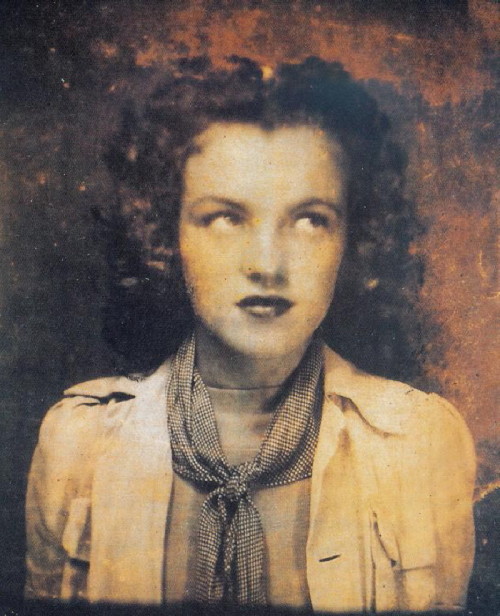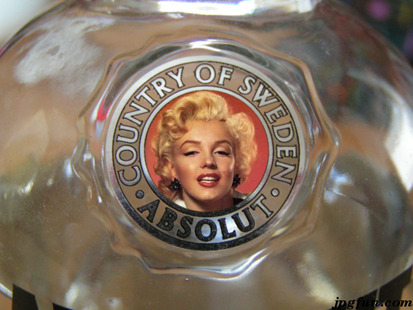
I've never fooled anyone. I've let people fool themselves.
They didn't bother to find out who and what I was.
Instead they would invent a character for me.
I wouldn't argue with them.
I wouldn't argue with them.
They were obviously loving somebody I wasn't.
― Marilyn Monroe.
On August 5th of 2012, it will be fifty years since the death of Norma Jeane Baker, also known at various points throughout her life as Norma Jeane Mortenson, Norma Jeane Dougherty, Norma Jeane DiMaggio and, most famously, Marilyn Monroe.
Norma Jeane (pictured above) died in 1962 - the death of an older woman, alone in her bed with a stomach full of barbiturates. Yet, it would seem that, even today, Marilyn Monroe remains very much alive and well. Actually, she's everywhere.
Her face adorns a huge array of consumer products, including clothing, handbags, leather furniture, cigarette lighters, homewares, and even vodka bottles. According to Forbes Magazine, Monroe's name, voice and likeness continue to earn approximately $8 million every year, with no sign of profits declining any time soon.

The cultural (or should that be, pop-cultural?) fascination with Marilyn Monroe is further evidenced by the steady sales of over 600 books written about her life. She has been the subject of over a dozen film and television biographies, portrayed by actresses including Mira Sorvino, Michelle Williams, and in one upcoming tribute, Naomi Watts. She is regularly listed as having one of the most recognisable faces in the world.
And, despite her luscious figure, it is always her face, framed by its platinum halo, which is the most articulated in these images. The problem is, whatever image of Marilyn Monroe you encounter, in whatever format and emblazoned on whatever piece of mechandise, she's apt to be smiling.
Call it ironic, anachronistic, or even downright ghoulish, but the insistent fetishization of Monroe's beautiful face, and particularly of her smile, belies a few uncomfortable facts. Firstly, that this was the face of a deeply disturbed and unhappy woman who apparently took her own life. Secondly, that Marilyn Monroe simply does not exist. And she never did.
In the manner of many a mythological being, Marilyn Monroe emerged fully-formed from the void at some point during 1945, around the beginning of the time that the world began to forget Norma Jeane, if she had ever been known at all. Many volumes have detailed the procedures involved in the metamorphosis; the acting, singing and deportment lessons, the meticulous attention to makeup, lighting, and camera angles, the cosmetic surgeries and hormone creams, and the drawn-out search for the "right" shade of blonde, to name but a few. Studio executives determined that Norma Jeane should take her mother's maiden name of Monroe, and being the types of guys who prefer to market an alliterative package, proposed the first name of Marilyn - a name that Norma Jeane is said to have both despised and initially protested.
The resultant package was only too marketable. At the height of her fame, Norman Mailer dubbed Monroe to represent "every man's love affair with America". The ultimate blonde bombshell, Monroe captivated women and men alike with her breathless lisp and coy glances. Rubbing shoulders (and sometimes more) with actors, politicians and sports-stars, the intelligentsia and the gutter-press, paupers and Presidents, Marilyn played the part of the perfect sex symbol. Not that she cared that much for the role. "Being a sex symbol is a heavy load to carry," she commented, "especially when one is tired, hurt and bewildered".
Tired? Hurt? Bewildered? These adjectives are almost irreconcilable with the lingering and saturating images of Marilyn Monroe at her flirty, voluptuous best. Yet, she frequently commented on her deep discomfort with the image she was forced to present. When travelling alone, she made notable attempts to shed the cumbersome image and name of Marilyn Monroe, checking into hotels under pseudonyms and wearing scarves to cover her famous, platinum curls. "A sex symbol becomes a thing", she said, "And I hate being a thing".
But we have made her a thing. The images that we see now of Marilyn Monroe represent a commodity, not a person. Even in death, Norma Jeane was unable to shed the image of Marilyn. Shortly after her premature death, Hugh Hefner made a public display of buying the burial plot next to hers, ostensibly so that he could spend eternity lying next to the most beautiful woman in the world. Over forty years later, he sold this plot at a substantial profit. Norma Jeane found no escape from Marily in death: she is still a fetishized sex symbol, even in her grave.
Tired? Hurt? Bewildered? These adjectives are almost irreconcilable with the lingering and saturating images of Marilyn Monroe at her flirty, voluptuous best. Yet, she frequently commented on her deep discomfort with the image she was forced to present. When travelling alone, she made notable attempts to shed the cumbersome image and name of Marilyn Monroe, checking into hotels under pseudonyms and wearing scarves to cover her famous, platinum curls. "A sex symbol becomes a thing", she said, "And I hate being a thing".
But we have made her a thing. The images that we see now of Marilyn Monroe represent a commodity, not a person. Even in death, Norma Jeane was unable to shed the image of Marilyn. Shortly after her premature death, Hugh Hefner made a public display of buying the burial plot next to hers, ostensibly so that he could spend eternity lying next to the most beautiful woman in the world. Over forty years later, he sold this plot at a substantial profit. Norma Jeane found no escape from Marily in death: she is still a fetishized sex symbol, even in her grave.
Andy Warhol also was quick to cash in on Norma Jeane's demise, glibly recounting that he had started experimenting with silkscreen printing during August 1962, and that "When Marilyn Monroe happened to die that month, I got the idea to make screens of her beautiful face." One of these prints now resides on permanent display in New York's Museum of Modern Art.
In 1973, Elton John released "Candle in the Wind", further glamorizing (and cashing in on) Marilyn Monroe's life and tragic death. At first glance, Sir Elton could be credited for his sensitivity, for his inclusion of the lines,
and his acknowledgement that,
Yet, the song becomes uncomfortable for its fetishization of female vulnerability. Illustrating Marilyn as a fragile candle, "never knowing who to cling to when the rain set in" clearly invites the listener to insert themselves as savior into an abortive rescue fantasy where Marilyn might just be alive today if only some special person would have treated her better. A certain hypocrisy also emanates from Elton's castigation of the media for feasting on Monroe, while he himself profits from picking the carcass of her suicide.
In any event, Elton John snatched back his tribute to Monroe in 1997 and slapped it onto the proceedings of Princess Diana's funeral, re-branded as "Goodbye English Rose". Now we have a choice of vulnerable, blonde, females for our rescue fantasy.
A worthy question in all this is, why Marilyn? Certainly she is seen to epitomise beauty and glamour but, both in her day and later, no more so than other screen sirens such as Rita Hayworth, Lana Turner or Kim Novak, whose beautiful visages have faded into a relative obscurity with the passage of time. Likewise, Marilyn's popularity can't be put down to her talent, or Bette Davis, Katharine Hepburn and Vivien Leigh would be similarly feted.
The jarring and inescapable truth is that our fascination with Marilyn is inextricable from the manner and timing of her death. She died at her peak and left an image that cannot be tarnished, of eternal youth, glamour and beauty. We will never see her aged mugshot in the manner of Zsa Zsa Gabor, or her eventual, octogenarian demise, like Elizabeth Taylor. When she picked up that bottle of pills in 1962, she escaped all temporal considerations and became ephemeral.
Certainly, it is no news that Hollywood loves a premature death because it contributes to a perpetually youthful star whose image is always saleable; one need only look to the examples of James Dean, Jean Harlow, or Natalie Wood for evidence of that fact. But there is no equivalence between these icons and Monroe, either in the manner of their deaths or the magnitude of their posthumous fame. Dean died in a car accident, Harlow of kidney failure, and Wood in mysterious circumstances suggesting foul play - Monroe is the only one suspected of dying by her own hand. And, crucially, only in the case of Monroe may we reasonably suspect that inability to cope with the incredible pressures placed on her by her fame and promoted public image were instrumental in her death.
And Marilyn is the only one worth $8 million per year, 5o years later.
Doubtless, a candle-lit vigil, or other expression of misguided public grief, will mark the anniversary of her death in August of this year. And doubtless, it will be accompanied by these very same images of Marilyn Monroe, worn on T-shirts or held up on placards, plastered on thermoses and wristwatches and cosmetic cases, even tattooed on bodies.
But in the context of her death, such iconography surpasses the inappropriate and borders upon the grotesque. We do her a disservice in remembering her under a name that she hated and which was not hers, and by glorifying in the manufactured images that burdened her so much. Trapped on a pedestal, Norma Jeane has been dehumanised by the glowing, golden Marilyn. Reduced to a buzzword, a sex symbol, a two-dimensional marketing strategy, this iconography freezes her forever as the very "thing" that she did not want to be. And it is these images, these conjured abstractions, that we forever associate with her, worshiping the construct that crushed Norma Jeane.
Moreover, what do we teach young women, focusing as we do on such glamorized depictions of Marilyn Monroe, if not that the safest path to fame and adulation is to look sexy, die young and leave a beautiful corpse? Even if beauty and fame cost you your happiness. Even if they cost your very life.
The only way to truly honour her life, or respect her death, is to do away with Marilyn Monroe.
We need to forget Marilyn, and start remembering Norma Jeane.
RIP Norma Jeane Baker
June 1, 1926 - August 5, 1962